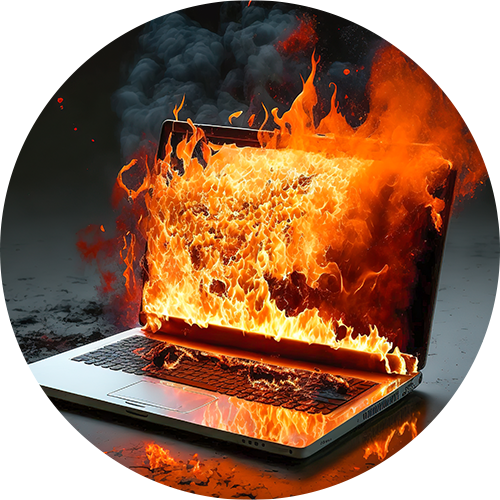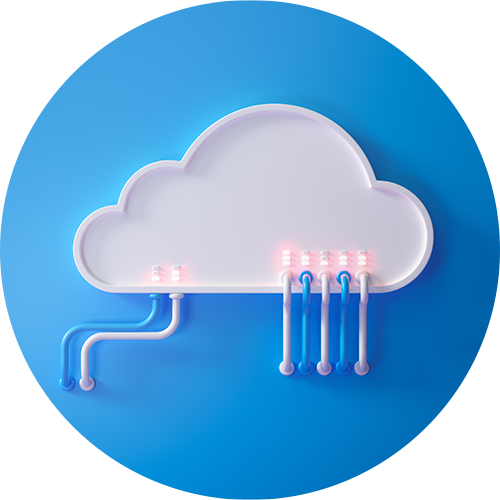
August 3, 2023
Saving Money On Technology Can Be Expensive For Your Business
It can be tempting to cut IT spending to make numbers look better. However, we believe that this can be counterproductive. It’s better to view technology as an investment that can improve your business’s profitability in the long run.
Purchasing professional office equipment can be quite costly, and spending money on tech gadgets without proper planning may result in your business incurring exorbitant expenses. In this blog post, we talk about some different things you should consider when purchasing new technology, and which types of technology we think are a great investment for any business.
Our criteria for making it on this list are that the technology either directly reduces expenses or makes processes more effective and efficient (meaning money saved in the long run). If your business costs are running out of hand, you understand how frustrating the situation could be. Your business may have landed some great deals, and your turnover is high, but the expenses that go into running the business may leave you with very little left.
As much as you may want to charge your clients more to try to increase your profit margin, doing so may force clients to switch to competitors. This leaves you with only one option – to assess your operations and determine what you can do to lower your expenses. Thanks to technology, there are several actions available.
The use of technology to save money is best realized when you do not do it under duress. Setting aside a considerable amount of time to determine what technology works best for your business is crucial. As much as technology adds convenience to your business processes, it is worth acknowledging that some may lead to unwarranted expenses.
For instance, the amount of power needed to keep lights/screens/projectors in meeting rooms turned on all the time may drastically increase the size of your electricity bills. At Biamp, we are all about creating smart technology that helps you get the most of out your meeting room equipment.
One of our solutions is a control device that connects to all your equipment and turns it on and off automatically when the room is being used.
See more about automatic control systems here.
Technology is meant to add convenience to your business and make things run smoothly. It is not supposed to be the reason you end up spending more.

Find the 'right' equipment
The fact that you are investing in technology does not outrightly imply that you can weather economic downtimes. A poor purchase may result in sluggish business processes which may be costlier in the long run. Thus, it is vital to make a detailed analysis of all the equipment bought to be sure that it has a higher return on investment – whether that is saving money on utilities or streamlining processes, saving time, or increasing productivity.
When investing in equipment, set aside a considerable amount of time to assess your business needs. The equipment you purchase should be aligned with your objectives.
Ok. So what can you do? We have lined up some questions you can ask yourself:
- Is there a specific gap that the equipment shall be used to fill?
- Are you seeking to improve productivity?
- Will the equipment give you a competitive edge?
- Will it make the office spaces more usable?
Only buy the equipment once you have answers to these and more questions.
Getting an outsider’s point of view is one sure way to determine if you are on the right equipment. When necessary, locate an external consultant who may help you assess your business needs before advising on the purchase. This is mostly done through cost-benefit analysis which highlights the pros and cons of different types of equipment.


Technology cost savings
Technological investment is not all about getting as much equipment as possible. Instead, it should be about determining what can be accomplished with the same equipment - so that you do not end up in a situation where you have spent a lot of money on several tools that can perform the same functions, cluttering your offices with unnecessary tools and increasing your operational costs.
There are different strategies you can use to reduce the amount of equipment required by your company. For starters, take note of all the things that you want to be done by a certain piece of equipment. Once that is determined, conduct some research on the different equipment that can accomplish the highlighted tasks. You may make a spreadsheet which enlists the different duties that various tools perform. The main goal is to get one that can perform as many tasks as possible.
In line with reducing equipment, maintaining your current equipment is crucial. When you schedule regular maintenance and take care of your equipment, you are reducing the likelihood of them breaking down, which may force you to incur huge expenses to replace the broken equipment.
Invest in automation simplify processes and increase productivity
Automation provides companies with tremendous potential to create value with technology. It is the basis upon which you can speed up processes, reduce costs, and implement new operating models. Automation makes can make all sorts of work processes easier.
To use meeting management as an example; all the factors that need to be taken into consideration when scheduling a meeting can be overwhelming.
The meeting host must:
- Find a day and time that fits the majority of meeting attendees
- Find a meeting room with the right size and capacity that contains the necessary equipment
- Determine when the meeting room is available and for how long
Scheduling a meeting should not be stressful and time-consuming, and technology can very helpful to automate some of these processes and make it easy to see whether rooms are available, who will be using them, and what time they will be available again.
An idea could, therefore, be to invest in a commercial AV system with room scheduling software and digital signage that hang in reception areas and outside the different meeting rooms.
These can:
- Show whether rooms are available
- Show when the rooms will be free and for how long
- Help meeting participants get to the right room
Automating these kinds of processes can save employees a lot of time and frustration, make the most out of your meeting facilities, increase productivity and make meetings start and finish on time.

Implement remote working policies
The costs involved in maintaining an office can be very high, more so if you’re a new company or a have a smaller number of employees. Expenses include rent, utilities, physical equipment, travelling expenses for employees who visit customers and many more. Employees also spend a significant amount of money each month travelling to and from work. There are also hidden costs for an organization; that of employees coming late to work due to traffic and other factors.
For instance, a study in the UK in 2012 showed that staff lateness costs the British economy over 9 billion pounds a year! Some of these costs can be reduced by implementing remote working policies, giving your employees higher flexibility to work from home, and giving your business the flexibility to hire talent in other cities or countries.
As the Internet matures and the cost of data reduces, remote working has become the most preferred mode of working. The cost of data and collaboration tools are almost negligible when you compare them to the above-mention costs. Gone are the days when collaboration and video conferencing tools were reserved for large enterprises.
Advances in technology have also made it possible for smaller businesses to enjoy the benefits of teleworking which include saving on money and time. A business needs to invest in the right tools to implement remote working. VOIP phone service is also an essential tool to facilitate communication between employees. VOIP provides the same service as a landline phone over your Internet connection instead of a phone company.
The quality of the calls is just as good- if not better- than the landline, and the costs are significantly lower. Skype is an example of a VOIP service. Other essential tools would include video conferencing solutions in meeting rooms such as displays, webcams, microphones and sound systems.
Adopt energy-saving technology
Climate and the environment have grown to be some of the world’s biggest concerns. People are taking action, changing their lifestyles and changing the types of technology they use to try and reduce their impact on the environment. Some actions include making offices more energy-efficient, recycling and reducing the amount of paper being used.
One added advantage of implementation energy-efficient technology, aside from the obvious environmental benefits, is that it can result in significant savings for your business. Another advantage is that this type of technology doesn’t require a huge investment. Simple replacements, such as changing incandescent bulbs to LEDs, can reduce the amount of energy used by almost 75%.
To put things into perspective, it is estimated that when you install a single CFL bulb, you could save as much as $80 in electricity expenses by the time that bulb’s lifetime runs out. Now think of the amount of money you would save by replacing all the incandescent bulbs in your organization!
Other types of eco-friendly technology you could install are automatic control systems with movement sensors. These would detect whether a room is being used and turn the lights and equipment off automatically if the room is not being used.
We’ve all experienced coming to work in the morning and finding all the lights and equipment still turned on because somebody forgot to turn it off before going home! Implementing this type of control system can make a significant positive impact on your energy consumption over time.


Paperless system in the office
Going paperless has benefits that surpass environmental implications. Paper documents and filing cabinets have been the way to organize information for decades.
People have now realized that paper is both an expensive and inefficient way of managing information, so they turn to one of the many types of electronic document management services available today.
Going paperless is, of course, something that takes time and effort, but the results would mean a more efficient and competitive business, where sharing information is easier and more streamlined, and employees’ time can be dedicated to more productive work.
Cloud storage
Cloud computing is a technology you cannot afford not to have in your organization. Cloud storage entails storing your data on the Internet (in a digital manner). As opposed to older storage systems which involve establishing in-house servers, cloud storage safely houses your data offsite.
One major benefit of this approach is that it is affordable and allows your employees to access data from any place in the world that they have an Internet connection. Cloud computing is an essential part of implementing remote working policies and going paperless in an organization.
Cloud storage is easy to use. Employees simply drag and drop files to the cloud. Saving data to the cloud happens almost instantly. One does not need any technical knowledge to do so. In the event that your organization is hit by a disaster such as fire outbreak, you do not need to panic because you can easily recover your data. Cloud storage could be viewed as a backup plan. The remote data can be retrieved at any time.
As your organization grows, cloud storage facilitates scalability. If you need more storage, the cloud allows you to adjust your hosting environment based on underlying needs. You have a high level of flexibility which cannot be achieved with traditional storage systems.
Summing it all up
Technology can be game-changer for many reasons - and reducing your business costs is definitely one of them. Your overall goal when purchasing new tech gadgets should always be to optimize, improve and make your business processes more efficient. That way you can guarantee that your tech spend is an investment, not an expense.
The various strategies discussed above give you an idea of what types of technology are available that help you achieve this very goal. Now it’s time for you to determine what makes sense for your business, and how you can get started with planning your next technology investment.

INSPIRING CASE STORIES
LET'S CONNECT
Fill out this form and a Biamp expert will reach out to you via phone or email. In some regions we may share your contact details and inquiry with one of our qualified third-party sales partners to follow up directly to ensure better local service. For more information please see our Privacy Policy.




